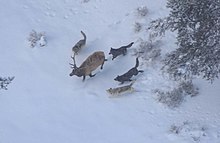
Persistence hunting
Persistence hunting, also known as endurance hunting or long-distance hunting is a variant of pursuit predation in which a predator will bring down a prey item via indirect means, such as exhaustion, heat illness or injury. Hunters of this type will typically display adaptions for distance running, such as longer legs, temperature regulation, and specialized cardiovascular systems.
Some endurance hunters may prefer to injure prey in an ambush before the hunt and rely on tracking to find their quarry.
Endurance hunting in humans and human ancestors
Adaptions for running
Humans are some of the best long distance runners in the animal kingdom, some hunter gatherer tribes practice this form of hunting into the modern era.Homo sapiens have the proportionally longest legs of all known human species, however all members of genus Homo have cursorial adaptions not seen in more arboreal hominids such as chimpanzees and orangutans.
Adaptions in temperature regulation
Sweat glands can be found in a variety of mammals, though these are usually limited to the soles of the feet, or chest in the case of the patas and rhesus monkeys. Humans are unique as our sweat glands provide an almost full-body covering, expending water in exchange for a consistent core body temperature.
Human hair is thickest generally on the head, allowing the hair to absorb sweat and insulate the brain case from the heat of the sun.
Endurance hunting in mammals
In canids
Wolves,dingoes, and painted dogs are known for running large prey down over long distances. All three species will inflict bites in order to further weaken the animal over the course of the hunt. Canids will also pant when hot. This has the double effect of cooling the animal via the evaporation of saliva while also increasing the amount of oxygen absorbed by the lungs. Despite their similar body shape, other canids are opportunistic generalists that can be broadly categorized as pursuit predators.
Wolves may have been initially domesticated due to their similar hunting techniques to humans. Several breeds of domestic dog have been bred with endurance in mind, such as the malamute, husky and Eskimo dog.
In feliforms
Spotted hyenas utilize a variety of hunting techniques depending on their chosen prey. They will occasionally use a similar strategy to canid endurance hunters, though their proportionally shorter legs makes this less effective.
Endurance hunting in reptiles
In archosaurs and turtles
No extant members of Archelosauria are known to be long-distance hunters, though various bird species may employ speedy pursuit predation. Living crocodilians and carnivorous turtles are specialized ambush predators and rarely if ever chase prey over great distances.
In lepidosaurs
Within Squamata, varanid lizards possess a well developed ventricular septum that completely separates the pulmonary and systemic sides of the circulatory system during systole, this unique heart structure allows varanids to run faster over longer distances than other lizards; they also utilize a forked tongue to track injured prey over large distances after a failed ambush. Several monitor lizard species such as Komodo dragons also utilize venom to ensure the death of their prey.
Endurance hunting in extinct species
Little evidence exists for endurance hunting in extinct species, though potential candidates include the dire wolf Aenocyon dirus due to its similar body shape to modern grey wolves.
Non-avian theropod dinosaurs such as derived tyrannosauroids and troodontids display cursorial adaptions which may have allowed for long-distance running. Derived theropods may have also had an avian style flow-through lung, allowing for highly efficient oxygen exchange.
Some non-mammalian theriodonts may have been capable of running relatively long distances due to their limbs having an erect stance as opposed to the sprawling stance of contemporary synapsids and reptiles.
See also
| Authority control: National |
|---|



